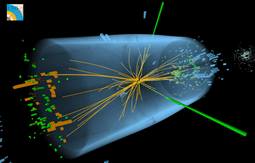Smashing Scientific Success
Image courtesy of CERN
Event recorded with the CMS detector in 2012 at a proton-proton centre of mass energy of 8 TeV. The event shows characteristics expected from the decay of the SM Higgs boson to a pair of photons (dashed yellow lines and green towers). The event could also be due to known standard model background processes.
Profound scientific answers often come from seemingly simple questions. Newton’s question about why things fall eventually led to the description of gravity. Einstein’s musings about what a light beam would look like if you rode alongside of it led to his theories of relativity. And now scientists could be a step closer to answering the question “Why do things have mass?”
As was announced on Wednesday, experiments at the Large Hadron Collider (LHC) at CERN have discovered a new particle, which could have the properties of the Higgs boson. The news came at a webcast Wednesday morning at CERN in Geneva, with simultaneous announcements in the United States by DOE’s Fermi National Accelerator Laboratory and Brookhaven National Laboratory, the lead institutions for U.S. participation in LHC research.
The Higgs is a long-sought subatomic particle that is thought to give other particles mass.Its existence was first predicted almost fifty years ago by a group of six physicists, including Peter Higgs. But it’s been exceptionally difficult to find traces of, even through intensive studies of more than two decades involving thousands of scientists.
Now scientists have now moved a step closer to its proof. If the particle is shown to be the Higgs, it will reveal an even deeper understanding of the universe. Moreover, scientists hope it will lead to new and even simpler questions, with even more profound answers.
More than 1,700 scientists, engineers, technicians and graduate students from U.S. institutions – including 89 American universities and seven DOE national laboratories – helped design, build and operate the LHC accelerator and its four particle detectors with support from the DOE Office of Science and the National Science Foundation. The vast majority of U.S. scientists participate in the LHC experiments from their home institutions, remotely accessing and analyzing the data through high-capacity networks and grid computing.
For additional context and commentary on this discovery, please see:
- Brookhaven Lab press release: http://www.bnl.gov/bnlweb/pubaf/pr/PR_display.asp?prID=1432&template=Today
- Fermilab fact sheet http://www.fnal.gov/pub/presspass/press_releases/2012/files/Higgs_Boson_FAQ_July2012.pdf, press release http://www.fnal.gov/pub/presspass/press_releases/2012/Higgs-Search-LHC-20120704.html and video http://www.youtube.com/watch?v=RIg1Vh7uPyw&lr=1
- KHGI-TV, UNL Joins the Hunt for the “God Particle:” http://www.nebraska.tv/story/18950742/unl-joins-the-hunt-for-the-god-particle
- Newsday, “LI physicist excited over ‘god particle’ news: http://www.newsday.com/business/technology/li-physicist-excited-over-god-particle-news-1.3821329?qr=1
- Reuters, “The Higgs Particle – what it is and what it does:” http://www.reuters.com/article/2012/07/04/us-science-higgs-idUSBRE86008K20120704 and “Cosmic theory’s Higgs lives to see his boson:” http://www.reuters.com/article/2012/07/04/us-science-higgs-boson-idUSBRE8630MR20120704
- ScienceDaily “Search for Higgs Boson at Large Hadron Collider Reveals New Particle:” http://www.sciencedaily.com/releases/2012/07/120704115008.htm
- Symmetry breaking, “What does it take to claim discovery of the Higgs?” http://www.symmetrymagazine.org/breaking/2012/06/29/what-does-it-take-to-claim-discovery-of-the-higgs/
- The New York Times, Physicists Find Elusive Higgs Boson Seen as Key to Universe: http://www.nytimes.com/2012/07/05/science/cern-physicists-may-have-discovered-higgs-boson-particle.html?src=me&ref=general
- The Washington Post, “Scientists’ search for Higgs boson yields new subatomic particle:” http://www.washingtonpost.com/national/health-science/scientists-discover-new-subatomic-particle-at-the-center-of-everything/2012/07/04/gJQADi8nMW_story.html
- The Wall Street Journal, “Discovery May Help Tell Universe’ Secrets:” http://online.wsj.com/article/SB10001424052702304141204577506093497519860.html and “Smashing Success:” http://online.wsj.com/article/SB10001424052702303962304577506741737994650.html?mod=WSJ_Opinion_AboveLEFTTop
The Department’s Office of Science is the single largest supporter of basic research in the physical sciences in the United States and is working to address some of the most pressing challenges of our time. For more information please visit http://science.energy.gov. For more information about Brookhaven Lab, please go to: http://www.bnl.gov/world/. And for more information about Fermilab, go to: http://www.fnal.gov/.
Charles Rousseaux is a Senior Writer in the Office of Science.


